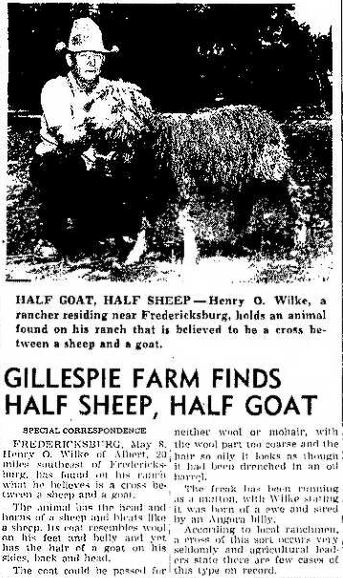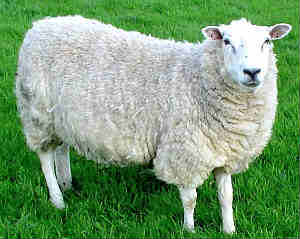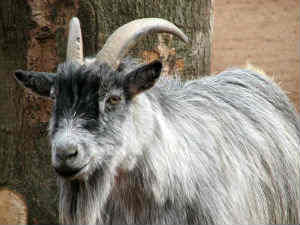Goat-sheep Hybrids
Mammalian Hybrids
|
Those animals are called hybrids which are born of diverse parents, as a mule from a mare and a he-ass; a burdo from a horse and a she-ass; hybrids from wild boars and pigs; tityrus from a ewe and a she-ass; mismo (muflone) from a female goat and a ram.
—St. Isidore of Seville, Etymologiae, Bk. XII (7th cen. A.D.)
|
In English these hybrids are called geeps, in French, chabins, and in Spanish, cabrunos. The term geep is also often applied to goat-sheep chimeras. Chimeras are organisms that are composed of cells derived from different zygotes. Goat-sheep chimeras, then, are composed of cells derived from both a sheep zygote and a goat zygote. In a broad sense, they are also goat-sheep hybrids. But they are not ordinary hybrids, that is, “sexual” hybrids. A sexual goat-sheep hybrid results when a goat gamete and a sheep gamete fuse during fertilization. (The issue of whether the term geep should be applied only to chimeras is discussed at the bottom of this page.)
Rates of conception from this cross are much higher with ram semen than with goat (but still much lower than in non-mixed matings). In fact, Shelton (1993) says that "When a male goat is mated to a female sheep, conception does not, in general, occur. The apparent explanation is a failure of sperm transport due to immunological antagonism. If a male sheep is mated to a female goat, conception will occur in a large number of cases, but the conception rate of 30-50% is below that of intra-species mating. The normal result of mating a male sheep to a female goat is a hybrid embryo which dies in the 40-50 day range, with some surviving for a more extended time." In a small scale study, Kelk et al. (1997) found that the fertilization rate was 72% in the usual direction and zero with the cross reversed.
Nevertheless, billies mating with ewes can in fact produce hybrids. Buffon (1749-1804, vol. 32, Supp. III, pp. 5-7) obtained eight hybrids (6 males and 2 females) from a billy crossed with ewes, and elsewhere (vol. 16, p. 533) noted that these hybrids were partially fertile. Spillman (1907) also reported a hybrid from a billy mating with a ewe. Various modern cases also contradict the idea that billy goats cannot sire geeps. For example, a geep born on an Irish farm in 2014 from a ewe that had mated with a billy appears in this very clear video.
A recent documented case describes a sheep-goat hybrid yeaned in 2000 at the Botswana Ministry of Agriculture, after a ram impregnated a female goat (Mine et al. 2000). Its outer coat was coarse and goat-like, its inner coat, woolly. The legs were long as in a goat, but the body was stout as in a sheep. The hybrid was sexually active and mounted both ewes and does even when they were not in heat, but his fertility was never properly evaluated and he was castrated when just 10 months old. It had a chromosome count of 57, half way between those of goats and sheep. (Indeed, F₁ hybrids of all types have chromosome counts half way between those of their two parents.)
Goat-sheep hybrids are sometimes fertile. These hybrids are occasionally fertile. For example, in New Zealand a ram impregnated a goat resulting in a female geep Stewart-Scott et al. (1990) report a female geep, the offspring of a ram and a goat doe, produced offspring when mated with a ram. In a similar case, a female geep, also pthe offspring of a ram and a goat, birthed a healthy backcross hybrid after mating with a ram (Cribiu et al. 1988; Tucker et al. 1989).
The occasional fertility of goat-sheep hybrids has long been recognized. Thus, Charles Darwin wrote, “Chevreul (Annal des Sci. Nat. 3 ser. Bot. Tom. VI. p. 188) affirms on the authority of Mr. Gay who must have had excellent opportunities of ascertaining the truth that the male hybrid from the male Goat & female sheep are paired with female sheep, & that the offspring, with 3/4 of the blood of the sheep, are propagated inter se, but that the character of the fleece deteriorates, so that after some generations they have to take a fresh cross with the half‐blood or first hybrid. This seems a very remarkable degree of fertility, for it implies that after several generations the hybrids with one‐fourth of the goats blood in them are fertile with the hybrid having half goats blood.”
Immune response. Tucker et al. (1989) say that later attempts to breed the fertile geep mentioned above were unsuccessful due to embryonic mortality, which suggests antibodies had been produced.
McGovern (1973) reported an acceleration in deaths of geep embryos, when the mother goats had earlier received skin grafts from sheep and injections of ram leukocytes. So the situation may parallel that seen in in Rh-negative human mothers. When a woman who is Rh-negative is impregnated by an Rh-positive man, the first pregnancy is usually uneventful, but subsequent pregnancies are likely to abort. This occurs when the woman is carrying a baby who is Rh-positive (like the father). When the mother's immune system is exposed to a baby's Rh-positive blood, it begins producing antibodies that are sensitized to destroy these "foreign" blood cells.
If it is the first pregnancy, chances are everything will be fine. The sensitized antibodies are typically not dangerous until subsequent pregnancies, when they've had time to grow in strength and number. However, all subsequent pregnancies are at great risk.
Gestation. The gestation period of a goat averages 150 days, that of a sheep, 147.
Chromosome counts. Goats have a chromosome count of 2n=60, and sheep, one of 2n=54.
Goat-sheep hybrids: Old sources
Goat-sheep hybrids were known in ancient times. For example, they are mentioned by Galen (De Semine, Bk. II, Ch. 1) and by Eugenius III Toletanus (De Amantibus Ambigenis), as well as St. Isidore of Seville (quoted at the top of this page). Bechstein (1801, p. 427) listed this hybrid. Wallace (1889, p. 163) gives a summary of early accounts of this cross.
|
Afterwards less memorable prodigies were also given credence: that certain folk had found their goats to have got woolly fleeces; that a hen had changed into a cock and a cock into a hen.
—Titus Livius, The History of Rome, 22.1.
|
References:
Allen and Short 1997 (p. 386); Anonymous 1850 (p. 143); Bunch et al. 1976; Buffon 1749-1804 (vol. 16, p. 533); Cribiu et al. 1988; Hancock and McGovern 1968; Hancock et al. 1968; Ilbery et al. 1967; Kelk et al. 1997; Letard and Théret 1952; Lühken et al. 2009; McGovern 1973; Mine et al. 2000; Prichard 1836 (p. 141); Roca and Rodero 1971; Steklenev 1972, 1983; Stewart-Scott et al. 1990; Tucker et al. 1989; Wallace 1889 (pp. 162-163); Weir 1888b; White 1900. Internet: tinyurl.com/yl4wask, tinyurl.com/9n49z9, tinyurl.com/3z4k2x8, tinyurl.com/h98o79b.
By the same author: Handbook of Avian Hybrids of the World, Oxford University Press (2006).
I have occasionally encountered the assertion that the term geep should be applied only to goat-sheep chimeras, that is, to animals that blend pure goat and sheep cells. People who make this assertion claim that goat-sheep hybrids produced by sexual intercourse (fusion of gametes) should not be called geeps. But, as I see it, the meaning of any given word is fluid, and I see no reason to cling to what words meant in the past or in some particular context. Thus, in the present case, even if it were true that geep was first used in 1984, when the first goat-sheep chimera was produced, I would not try to correct the innumerable people who use geep to mean "goat-sheep hybrid" instead of "goat-sheep chimera." Their usage of the word is in no way imprecise. When they use the word geep they mean "goat-sheep hybrid" so they are saying exactly what they mean. Moreover, the use of the word geep with the meaning "goat-sheep hybrid" long predates 1984. For example, a cursory search of the internet reveals the following passage, published in a veterinary journal in 1966: "GOAT x SHEEP = GEEP "Geeps" 'strange looking animals believed to be a cross between a goat and a sheep..." Another author, in 1964, wrote: "There was a dox : a cross between a dog and a fox ; a geep, a half-goat, half- sheep..." Even so, I would not suggest that the subsequent use of geep to mean "goat-sheep chimera" is somehow wrong. It's just an additional usage of the same word. People seize upon old words to describe new phenomena and there's nothing anyone can do about it. So I go with the flow. In fact, I enjoy the evolution of words and their meanings. I think it's futile to build fences around words in a vain effort to limit them to a single meaning.
 Above: An article in the San Antonio Express (May. 9, 1947, p. 2) about a goat-sheep hybrid yeaned by a ewe in Albert, Texas. The image, from an old newspaper, was bad in the original.
Above: An article in the San Antonio Express (May. 9, 1947, p. 2) about a goat-sheep hybrid yeaned by a ewe in Albert, Texas. The image, from an old newspaper, was bad in the original.
Most shared on Macroevolution.net:
Human Origins: Are we hybrids?
On the Origins of New Forms of Life
Mammalian Hybrids
Cat-rabbit Hybrids: Fact or fiction?
Famous Biologists
Dog-cow Hybrids
Georges Cuvier: A Biography
Prothero: A Rebuttal
Branches of Biology
Dog-fox Hybrids

